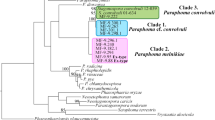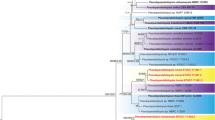Abstract
The known species of Pucciniales on the tree genus Annona (Annonaceae), Phakopsora cherimoliae, Batistopsora crucis-filii, B. pistila, as well as the anamorphic species of Aecidium annonae and Uredo rolliniae, were investigated by light microscopy and DNA sequencing. For DNA extraction, N-Phenacylthiazolium bromide (PTB) was used to achieve a higher yield of DNA from herbarium specimens. The phylogenetic analyses were based on the ITS1–5.8S–ITS2 region, partial LSU and SSU of the nuclear rDNA, and the mitochondrial cytochrome oxidase subunit 3. The molecular as well as the morphologic investigations indicated that the genus Batistopsora is synonymous with Phakopsora. The two Batistopsora species appeared in all phylogenies within Phakopsora. They form a monophyletic clade together with P. cherimoliae as well as with the anamorphic Uredo rolliniae and the herein newly described species Phakopsora annonae-sylvaticae. Therefore, the following new combinations have been made: Phakopsora crucis-filii, P. pistila and P. rolliniae. Phakopsora crucis-filii and P. pistila could not be distinguished by the used sequences but are morphologically and ecologically well separated. This contradiction is discussed. Phakopsora crucis-filii is firstly reported as a pathogen on the fruit tree Annona squamosa. The species show host preferences to species groups of Annona at the sub-generic level and distribution patterns similar to those of their hosts. In comparison with the rust fungal genus Dasyspora, which occurs on Xylopia (Annonaceae) also in the Neotropics, the Phakopsora spp. on Annona show similar phylogeographical patterns. The redetermination of the host plants has shown that A. annonae does not occur on Annonaceae but on Diospyros hispida (Ebenaceae). Therefore, the new species, Aecidium verannonae, has to be described for the Aecidium species, which occurs really on Annona. It did not appear to be closely related to the Phakopsoraceae in the phylogenetic analysis. An identification key for all known rust fungi on Annona is given.







Similar content being viewed by others
References
Aime MC (2006) Toward resolving family-level relationships in rust fungi (Uredinales). Mycoscience 47:112–122
Beenken L, Berndt R (2010) Rust fungi on Annonaceae: the genus Sphaerophragmium. Mycologia 102(3):650–663
Beenken L, Zoller S, Berndt R (2012) Rust fungi on Annonaceae II: the genus Dasyspora Berk. & M. A. Curtis. Mycologia 104:659–681
Berndt R (2013) First catalogue of the rust fungi of French Guiana, northern South America. Mycol Prog 12:193–211
Berndt R, Freire F, Piatek M, Wood AR (2008) New species of Phakopsora (Basidiomycota, Uredinales) on Dissotis, Melhania and Merremia from Cameroon, South Africa and Brazil. Sydowia 60:15–24
Braun U (2012) The impacts of the discontinuation of dual nomenclature of pleomorphic fungi: the trivial facts, problems, and strategies. IMA Fungus 3(1):81–86
Bruns TD (2001) ITS reality. Inoculum 52(6):2–3
Buriticá CP (1999) La familia Phakopsoraceae en el Neotrópico III, generos: Batistopsora y Phakopsora. Rev Acad Colomb Cienc 23:271–305
Buriticá P, Hennen JF (1994) Familia Phakopsoraceae (Uredinales). 1. Géneros anamórphicos y teleomórphicos. Rev Acad Colomb Cienc 19:47–62
Busch P (1913) Anatomisch-systematische Untersuchung der Gattung Diospyros. Thesis, Erlangen
Castresana J (2000) Selection of conserved blocks from multiple alignments for their use in phylogenetic analysis. Mol Biol Evol 17:540–552
Castro AAJF, Martins FR, Tamashiro JY, Shepherd GJ (1999) How rich is the flora of Brazilian cerrados? Ann Mo Bot Gard 86:192–224
Cavalcanti TB, Ramos AE (eds) (2003) Flora do Distrito Federal Brasil. Vol. 3. Brasilia.
Chatrou LW, Rainer H, Maas PJM (2004) Annonaceae (Soursop Family). In: Smith N, Mori SA, Hendreson A, Stevenson DW, Heald SV (eds) Flowering plants of the neotropics. The New York botanical garden. Princeton University Press, Princeton, pp 18–20
Contreras LS, Lersten NR (1984) Extrafloral nectaries in Ebenaceae: anatomy, morphology, and distribution. Am J Bot 71(6):865–872
Cummins GB, Hiratsuka Y (2003) Illustrated genera of rust fungi, 3rd edn. APS Press, St. Paul
Dianese JC, Medeiros RB, Santos LTP, Furlanetto C, Sanchez M, Dianese AC (1993) Batistopsora gen. nov. and new Phakopsora, Ravenelia, Cerotelium, and Skierka species from the Brazilian cerrado. Fitopatol Bras 18(3):436–450
Ferrari JT, de C Nogeira EM, Hennen JF, Figueiredo MB, Coutinho LN, Louzeiro IM (2004) Ocorrência e controle da ferrugem em Cherimólia no estado de São Paulo. Arq Inst Biol São Paulo 71:95–98
Fries RE (1931) Revision der Arten einiger Anonaceen-Gattungen II. Acta Horti Bergani 10:129–341, 27 plates
Fries RE (1939) Revision der Arten einiger Anonaceen-Gattungen III. Acta Horti Bergani 12:1–220, 20 plates
Funk V, Hollowell T, Berry P, Kelloff C, Alexander SN (2007) Checklist of the plants of the Guiana shield (Venezuela: Amazonas, Bolivar, Delta Amacuro; Guyana, Surinam, French Guiana). Contr US Natl Herb 55:1–584
Gottsberger G, Silberbauer-Gottsberger I (2006) Life in the Cerrado: a South American tropical seasonal vegetation. Vol. I. Origin, structure, dynamics and plant use. Reta Verlag, Ulm, pp 1–279
Harrington TC, Rizzo DM (1999) Defining species in the fungi. In: Worrall JJ (ed) Structure and dynamics of fungal populations. Kluwer, Dordrecht, pp 43–71
Hawksworth DL, McNeill J, de Beer ZW, Wingfield MJ (2013) Names of fungal species with the same epithet applied to different morphs: how to treat them. IMA Fungus 4(1):53–56
Hennen JF, Figueiredo MB. de Carvalho AA, Hennen PG (2005) Catalogue of the species of plant rust fungi (Uredinales) of Brazil, Jardim Botânico do Rio de Janeiro, Rio de Janeiro http://www.jbrj.gov.br/publica/uredinales/Brazil_Catalogue1drevisado.pdf
Hernández JR, Aime MC, Henkel TW (2005) The rust fungi (Uredinales) of Guyana. Sydowia 57(2):189–222
Hiratsuka Y, Hiratsuka N (1980) Morphology of spermogonia and taxonomy of rust fungi. Rept Toottori Mycol Inst 18:257–268
Huelsenbeck JP, Ronquist F (2001) MrBayes: Bayesian inference of phylogenetic trees. Bioinformatics 17:754–755
Huson DH, Richter DC, Rausch C, Dezulian T, Franz M, Rupp R (2007) Dendroscope - an interactive viewer for large phylogenetic trees. BMC Bioinforma 8:460
Kirk PM, Cannon PF, David JC, Stalpers J (eds) (2008) Dictionary of fungi, 10th edn. CABI Publishing, Oxon
Maas PJM, Westra LYT (1992) Rollinia. Flora Neotropica 57:1–188
Maddison DR, Maddison WP (2003) MacClade 4.0. Sinauer Associates, Sunderland
McNeill J, Barrie FR, Buck WR, Demoulin V, Greuter W, Hawksworth DL, Herendeen PS, Knapp S, Marhold K, Prado J, Prud’homme Van Reine WF, Smith GF, Wiersema JH, Turland NJ (2012) International code of nomenclature for algae, fungi and plants (Melbourne code) adopted by the Eighteenth International Botanical Congress Melbourne, Australia, July 2011. Koeltz Scientific Books, Regnum Vegetabile 154: i–xxx, 1–208. http://www.iapt-taxon.org/nomen/main.php
Metcalfe CR, Chalk L (1957) Anatomy of the Dicotyledons, vol I +II. Clarendon, Oxford
Morton JF (1987) Fruits of warm climates. Creative Resource Systems, Winterville
Newcombe G, Stirling B, McDonald S, Bradshaw HDJ (2000) Melampsora × columbiana, a natural hybridof M. medusae and M. occidentalis. Mycol Res 104:261–274
Ono Y, Buriticá P, Hennen JF (1992) Delimitation of Phakopsora, Physopella, and Cerotelium and their species on Leguminosae. Mycol Res 96:825–850
Park RF, Wellings CR (2012) Somatic hybridization in the uredinales. Annu Rev Phytopathol 50:219–239
Pfunder M, Schürch S, Roy BA (2001) Sequence variation and geographic distribution of pseudoflower-forming rust fungi (Uromyces pisi s. lat.) on Euphorbia cyparissias. Mycol Res 105:57–66
Ploetz RC (2003) Diseases of atemoya, cherimoya, soursop, sugar apple and related fruit crops. In: Ploetz RC (ed) Diseases of tropical fruit crops. CABI Publishing, Cambridge, pp 21–34
Raffaele S, Farrer RA, Cano LM, Studholme DJ, MacLean D, Thines M, Jiang RHY, Zody MC, Kunjeti SG, Donofrio NM, Meyers BC, Nusbaum C, Kamoun S (2010) Genome evolution following host jumps in the Irish potato famine pathogen lineage. Science 330:1540–1543
Rainer H (2007) Monographic studies in the genus Annona L. (Annonaceae): inclusion of the genus Rollinia A.St.-Hil. Ann Naturhist Mus Wien B 108:191–205
Richardson JE, Chatrou LW, Mols JB, Erkens RHJ, Pirie MD (2004) Historical biogeography of two cosmopolitan families of flowering plants: annonaceae and rhamnaceae. Phil Trans R Soc London B 359:1495–1508
Ronquist F, Huelsenbeck JP (2005) MrBayes. Version 3.1.2. Bayesian analysis of phylogeny. GNU General Public License
Schoch CL, Seifert KA, Huhndorf S, Spouge RV, Levesque CA, Chen W, Fungal Barcoding Consortium (2012) Nuclear ribosomal internal transcribed spacer (ITS) region as a universal DNA barcode marker for fungi. PNAS 109:6241–6246. doi:10.1073/pnas.1117018109
Stamatakis A (2006) RAxML-VI-HPC: maximum likelihood-based phylogenetic analyses with thousands of taxa and mixed models. Bioinformatics 22(21):2688–2690
Stukenbrock EH, Quaedvlieg W, Javan-Nikhah M, Zala M, Crous PW, McDonald BA (2012a) Zymoseptoria ardabilia and Z. pseudotritici, two progenitor species of the septoria tritici leaf blotch fungus Z. tritici (synonym: Mycosphaerella graminicola). Mycologia 104:1397–1407
Stukenbrock EH, Christiansen FB, Hansen TT, Dutheil JY, Schierup MH (2012b) Fusion of two divergent fungal individuals led to the recent emergence of a unique widespread pathogen species. PNAS 109:10954–10959
Sydow P, Sydow H (1924) Monographia Uredinarum, Vol IV Uredineae imperfectae. Gebrüder Bornträger, Leipzig, pp 1–671
Telle S, Thines M (2008) Amplification of cox2 (620 bp) from 2 mg of up to 129 years old Herbarium specimens, comparing 19 extraction methods and 15 polymerases. PLoS ONE 3(10):e3584
Thiers B (2011) [continuously updated]. Index Herbariorum: a global directory of public herbaria and associated staff. New York Botanical Garden’s Virtual Herbarium. http://sweetgum.nybg.org/ih/
Turchetto-Zolet AC, Pinheiro F, Salgueiro F, Palma-Silva C (2013) Phylogeographic patterns shed light on evolutionary process in South America. Mol Ecol 22:1193–1213
Vialle A, Feau N, Allaire M, Didukh M, Martin F, Moncalvo JM, Hamelin RC (2009) Evaluation of mitochondrial genes as DNA barcode for Basidiomycota. Mol Ecol Resour 9(1):99–113
Vilgalys R, Hester M (1990) Rapid genetic identification and mapping of enzymatically amplified ribosomal DNA from several Cryptococcus species. J Bacteriol 172(8):4238–4246
Wallnöfer B (2012) A revision of neotropical Diospyros (Ebenaceae): part 5. Ann Naturhist Mus Wien B 113:223–251
White TJ, Bruns T, Lee S, Taylor J (1990) Amplification and direct sequencing of fungal ribosomal RNA genes for phylogenetics. In: Innis MA, Gelfand DH, Sninsky JJ, White TJ (eds) PCR protocols: a guide to methods and applications. Academic, San Diego, pp 315–322
Acknowledgments
The author thanks the curators of B, BPI, BRUX, M, NY, PC, PUR, S, W and Z + ZT for loan of specimens and F. Freire (Planalto do Pici – Fortaleza) for sending recent material from Brazil. The author is much obliged to B. Wallnöfer (Vienna) for the identification of the host plant of Aecidium annonae. H. Rainer (Vienna) gave useful information about the species of genus Annona and Annonaceae in general. I. Cordeiro and D. Carneiro-Torres (Sao Paulo) kindly identified the host of P. argentiniensis. The molecular part of the study was done in the lab of the Genetic Diversity Centre (GDC) of ETH Zurich; the author thanks especially S. Zoller (GDC, Zurich) for his work on the phylogenetic analyses. R. Berndt (Zurich) kindly contributed Fig. 5b–d and helpful comments to the manuscript. The Swiss National Fund (SNF) financially supported this study (Project number 135624).
Author information
Authors and Affiliations
Corresponding author
Rights and permissions
About this article
Cite this article
Beenken, L. Pucciniales on Annona (Annonaceae) with special focus on the genus Phakopsora . Mycol Progress 13, 791–809 (2014). https://doi.org/10.1007/s11557-014-0963-5
Received:
Revised:
Accepted:
Published:
Issue Date:
DOI: https://doi.org/10.1007/s11557-014-0963-5




